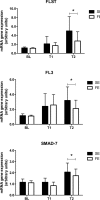Effect of eccentric action velocity on expression of genes related to myostatin signaling pathway in human skeletal muscle
- PMID: 30455539
- PMCID: PMC6234307
- DOI: 10.5114/biolsport.2018.71600
Effect of eccentric action velocity on expression of genes related to myostatin signaling pathway in human skeletal muscle
Abstract
The aim of this study was to investigate the effects of an acute bout of eccentric actions, performed at fast velocity (210º.s-1) and at slow velocity (20º.s-1), on the gene expression of regulatory components of the myostatin (MSTN) signalling pathway. Participants performed an acute bout of eccentric actions at either a slow or a fast velocity. Muscle biopsy samples were taken before, immediately after, and 2 h after the exercise bout. The gene expression of the components of the MSTN pathway was assessed by real-time PCR. No change was observed in MSTN, ACTRIIB, GASP-1 or FOXO-3a gene expression after either slow or fast eccentric actions (p > 0.05). However, the MSTN inhibitors follistatin (FST), FST-like-3 (FSTL3) and SMAD-7 were significantly increased 2 h after both eccentric actions (p < 0.05). No significant difference between bouts was found before, immediately after, or 2 h after the eccentric actions (slow and fast velocities, p > 0.05). The current findings indicate that a bout of eccentric actions activates the expression of MSTN inhibitors. However, no difference was observed in MSTN inhibitors' gene expression when comparing slow and fast eccentric actions. It is possible that the greater time under tension induced by slow eccentric (SE) actions might compensate the effect of the greater velocity of fast eccentric (FE) actions. Additional studies are required to address the effect of eccentric action (EA) velocities on the pathways related to muscle hypertrophy.
Keywords: Fast eccentric; GDF-8; Gene expression; Signalling; Slow eccentric.
Conflict of interest statement
The authors declare that there is no conflict of interests regarding the publication of this paper.
Figures



Similar articles
-
Effects of concentric and eccentric muscle actions on serum myostatin and follistatin-like related gene levels.J Sports Sci Med. 2004 Dec 1;3(4):226-33. eCollection 2004 Dec. J Sports Sci Med. 2004. PMID: 24624007 Free PMC article.
-
Hormone therapy and maximal eccentric exercise alters myostatin-related gene expression in postmenopausal women.J Strength Cond Res. 2012 May;26(5):1374-82. doi: 10.1519/JSC.0b013e318251083f. J Strength Cond Res. 2012. PMID: 22395277
-
Time-specific effects of acute eccentric exercise on myostatin, follistatin and decorin in the circulation and skeletal muscle in rats.Physiol Res. 2022 Dec 16;71(6):783-790. doi: 10.33549/physiolres.934833. Epub 2022 Oct 13. Physiol Res. 2022. PMID: 36281727 Free PMC article.
-
Greater muscle damage induced by fast versus slow velocity eccentric exercise.Int J Sports Med. 2006 Aug;27(8):591-8. doi: 10.1055/s-2005-865920. Int J Sports Med. 2006. PMID: 16874584
-
Repeated bouts of fast velocity eccentric contractions induce atrophy of gastrocnemius muscle in rats.J Muscle Res Cell Motil. 2015 Oct;36(4-5):317-27. doi: 10.1007/s10974-015-9426-0. Epub 2015 Oct 17. J Muscle Res Cell Motil. 2015. PMID: 26476829
Cited by
-
Iron Status in Elderly Women Impacts Myostatin, Adiponectin and Osteocalcin Levels Induced by Nordic Walking Training.Nutrients. 2020 Apr 17;12(4):1129. doi: 10.3390/nu12041129. Nutrients. 2020. PMID: 32316589 Free PMC article.
References
-
- Allen D.L, Unterman T.G. Regulation of myostatin expression and myoblast differentiation by FoxO and SMAD transcription factors. Am J Physiol Cell Physiol. 2007;292:C188–199. - PubMed
-
- Aoki M.S, Soares A.G, Miyabara E.H, Baptista I.L, Moriscot A.S. Expression of genes related to myostatin signaling during rat skeletal muscle longitudinal growth. Muscle Nerve. 2009;40:992–999. - PubMed
-
- Bustin S.A. Quantification of mRNA using real-time reverse transcription PCR (RT-PCR): trends and problems. J Mol Endocrinol. 2002;29:23–39. - PubMed
-
- Chapman D.W, Newton M, McGuigan M, Nosaka K. Effect of lengthening contraction velocity on muscle damage of the elbow flexors. Med. Sci. Sports Exerc. 2008;40:926–933. - PubMed
-
- Chesley A, MacDougall J.D, Tarnopolsky M.A, Atkinson S.A, Smith K. Changes in human muscle protein synthesis after resistance exercise. J Appl Physiol. 1992;73:1383–1388. - PubMed
LinkOut - more resources
Full Text Sources
Research Materials
Miscellaneous
